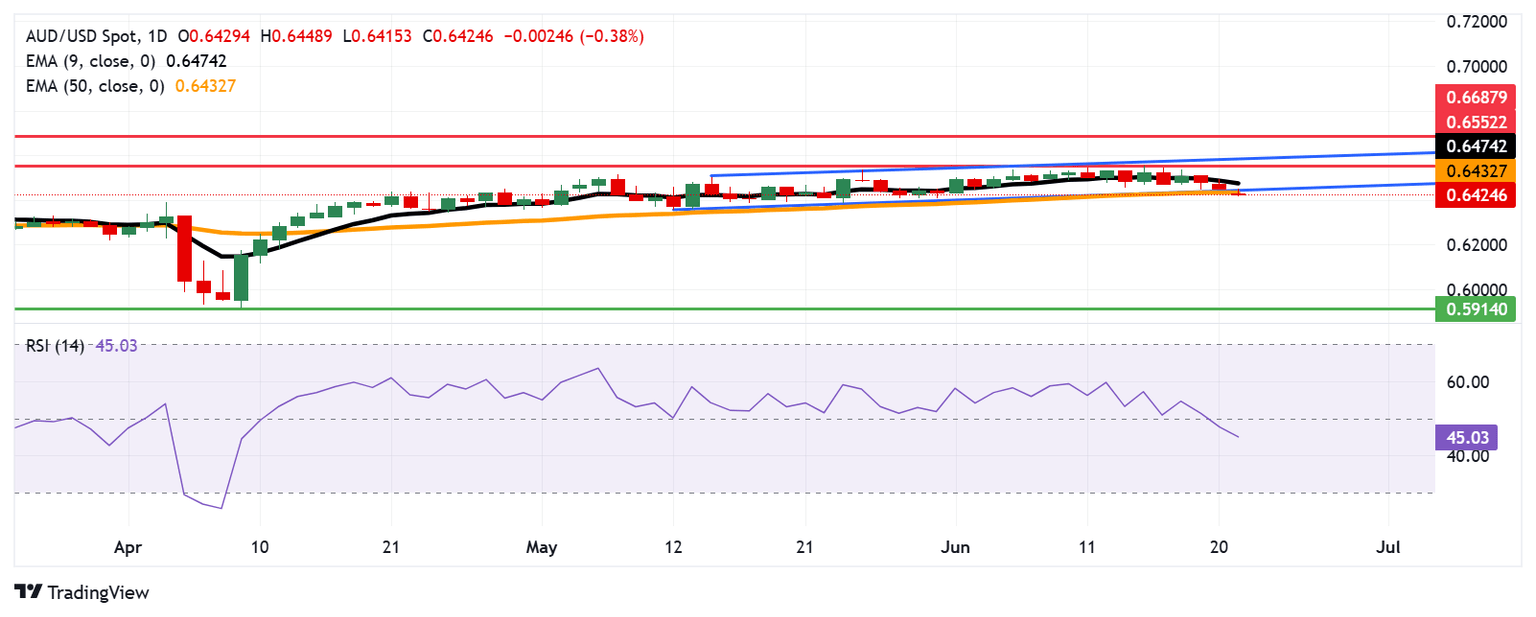Australian Dollar struggles due to increased risk aversion, US PMI awaited
- The Australian Dollar depreciates as market sentiment weakens following US attacks on Iran's three nuclear facilities.
- Australia’s Services PMI improved to 51.3 in June from 50.6 prior, while the Composite PMI increased to 51.2 from 50.5.
- Fed Governor Christopher Waller said that the US central bank could start cutting interest rates as soon as next month.

The Australian Dollar (AUD) depreciated against the US Dollar (USD) on Monday, extending its losses for the third successive session. The AUD/USD pair remains weaker amid dampened risk sentiment, driven by the escalating Middle East tension.
US President Donald Trump announced late Saturday that he had "obliterated" Iran's three nuclear facilities, including Fordow, Natanz, and Isfahan, in strikes overnight, in coordination with an Israeli assault. Iranian parliament approved a measure to close the Strait of Hormuz. Iran has threatened to close the strait in the past but has never followed through on the move, per Reuters.
S&P Global reported that the preliminary Australia Manufacturing Purchasing Managers Index (PMI) remained consistent at a 51.0 reading in June. Meanwhile, the Services PMI edged higher to 51.3 from the previous reading of 50.6, while the Composite PMI improved to 51.2 in June from 50.5 prior.
Australian Dollar declines due to increased risk aversion
- The US Dollar Index (DXY), which measures the value of the US Dollar against six major currencies, is losing ground and trading at around 99.600 at the time of writing.
- Federal Reserve (Fed) Governor Christopher Waller noted on Friday that the US central bank could start easing monetary policy as soon as next month, signaling flexibility amid global economic uncertainty and rising geopolitical risks.
- The US Fed decided to keep the interest rate steady at 4.5% in June as widely expected. The Federal Open Market Committee (FOMC) still sees around 50 basis points of interest rate cuts through the end of 2025. However, Fed Chair Jerome Powell warned that ongoing policy uncertainty will keep the Fed in a rate-hold stance, and any rate cuts will be contingent on further improvement in labor and inflation data.
- The People’s Bank of China (PBOC) decided to leave its Loan Prime Rates (LPRs) unchanged on Friday. The one-year and five-year LPRs were at 3.00% and 3.50%, respectively.
- China Retail Sales rose 6.4% year-over-year in May, surpassing the 5.0% expected and April’s 5.1% increase. Meanwhile, Industrial Production increased 5.8% YoY, but came in below the 5.9% forecast and 6.1% prior.
- Moreover, the National Bureau of Statistics (NBS) in China noted that the domestic economy is expected to have remained generally stable for the first half (H1) of 2025. However, economic growth in China may struggle since the second quarter due to uncertain trade policies.
- Australian Bureau of Statistics reported on Thursday that Employment Change fell by 2.5K in May against an 87.6K increase in April (revised from 89K) and the consensus forecast of a 25K rise. Furthermore, the Unemployment Rate steadied at 4.1% in May, as expected.
Australian Dollar moves below 50-day EMA near 0.6500
AUD/USD is trading around 0.6430 on Monday. The technical analysis of the daily shows the pair has broken below the ascending channel pattern, which could cause the emergence of a bearish bias. Additionally, the 14-day Relative Strength Index (RSI) has moved below the 50 mark, strengthening the bearish bias. The pair is falling below the nine-day Exponential Moving Average (EMA), indicating that short-term price momentum is weaker.
On the downside, the AUD/USD pair may test the “throwback support” around the psychological level of 0.6400. A break below this level may prompt the pair to navigate the region around 0.5914, the lowest level since March 2020.
The primary barrier appears at the 50-day EMA of 0.6432, followed by the lower boundary of the ascending channel around 0.6450. A successful rebound to the channel would revive the bullish bias and support the pair to test the nine-day EMA at 0.6474. A break above this level would reinforce the bullish sentiment and lead the AUD/USD pair to approach the seven-month high of 0.6552, which was recorded on June 16.
AUD/USD: Daily Chart

Australian Dollar PRICE Today
The table below shows the percentage change of Australian Dollar (AUD) against listed major currencies today. Australian Dollar was the weakest against the Euro.
| USD | EUR | GBP | JPY | CAD | AUD | NZD | CHF | |
|---|---|---|---|---|---|---|---|---|
| USD | -0.38% | -0.11% | 0.31% | 0.05% | 0.41% | 0.50% | 0.05% | |
| EUR | 0.38% | 0.25% | 0.75% | 0.44% | 0.75% | 0.89% | 0.40% | |
| GBP | 0.11% | -0.25% | 0.53% | 0.19% | 0.50% | 0.65% | 0.15% | |
| JPY | -0.31% | -0.75% | -0.53% | -0.26% | 0.07% | 0.26% | -0.33% | |
| CAD | -0.05% | -0.44% | -0.19% | 0.26% | 0.40% | 0.45% | -0.04% | |
| AUD | -0.41% | -0.75% | -0.50% | -0.07% | -0.40% | 0.12% | -0.35% | |
| NZD | -0.50% | -0.89% | -0.65% | -0.26% | -0.45% | -0.12% | -0.48% | |
| CHF | -0.05% | -0.40% | -0.15% | 0.33% | 0.04% | 0.35% | 0.48% |
The heat map shows percentage changes of major currencies against each other. The base currency is picked from the left column, while the quote currency is picked from the top row. For example, if you pick the Australian Dollar from the left column and move along the horizontal line to the US Dollar, the percentage change displayed in the box will represent AUD (base)/USD (quote).
Australian Dollar FAQs
One of the most significant factors for the Australian Dollar (AUD) is the level of interest rates set by the Reserve Bank of Australia (RBA). Because Australia is a resource-rich country another key driver is the price of its biggest export, Iron Ore. The health of the Chinese economy, its largest trading partner, is a factor, as well as inflation in Australia, its growth rate and Trade Balance. Market sentiment – whether investors are taking on more risky assets (risk-on) or seeking safe-havens (risk-off) – is also a factor, with risk-on positive for AUD.
The Reserve Bank of Australia (RBA) influences the Australian Dollar (AUD) by setting the level of interest rates that Australian banks can lend to each other. This influences the level of interest rates in the economy as a whole. The main goal of the RBA is to maintain a stable inflation rate of 2-3% by adjusting interest rates up or down. Relatively high interest rates compared to other major central banks support the AUD, and the opposite for relatively low. The RBA can also use quantitative easing and tightening to influence credit conditions, with the former AUD-negative and the latter AUD-positive.
China is Australia’s largest trading partner so the health of the Chinese economy is a major influence on the value of the Australian Dollar (AUD). When the Chinese economy is doing well it purchases more raw materials, goods and services from Australia, lifting demand for the AUD, and pushing up its value. The opposite is the case when the Chinese economy is not growing as fast as expected. Positive or negative surprises in Chinese growth data, therefore, often have a direct impact on the Australian Dollar and its pairs.
Iron Ore is Australia’s largest export, accounting for $118 billion a year according to data from 2021, with China as its primary destination. The price of Iron Ore, therefore, can be a driver of the Australian Dollar. Generally, if the price of Iron Ore rises, AUD also goes up, as aggregate demand for the currency increases. The opposite is the case if the price of Iron Ore falls. Higher Iron Ore prices also tend to result in a greater likelihood of a positive Trade Balance for Australia, which is also positive of the AUD.
The Trade Balance, which is the difference between what a country earns from its exports versus what it pays for its imports, is another factor that can influence the value of the Australian Dollar. If Australia produces highly sought after exports, then its currency will gain in value purely from the surplus demand created from foreign buyers seeking to purchase its exports versus what it spends to purchase imports. Therefore, a positive net Trade Balance strengthens the AUD, with the opposite effect if the Trade Balance is negative.
Author

Akhtar Faruqui
FXStreet
Akhtar Faruqui is a Forex Analyst based in New Delhi, India. With a keen eye for market trends and a passion for dissecting complex financial dynamics, he is dedicated to delivering accurate and insightful Forex news and analysis.

















